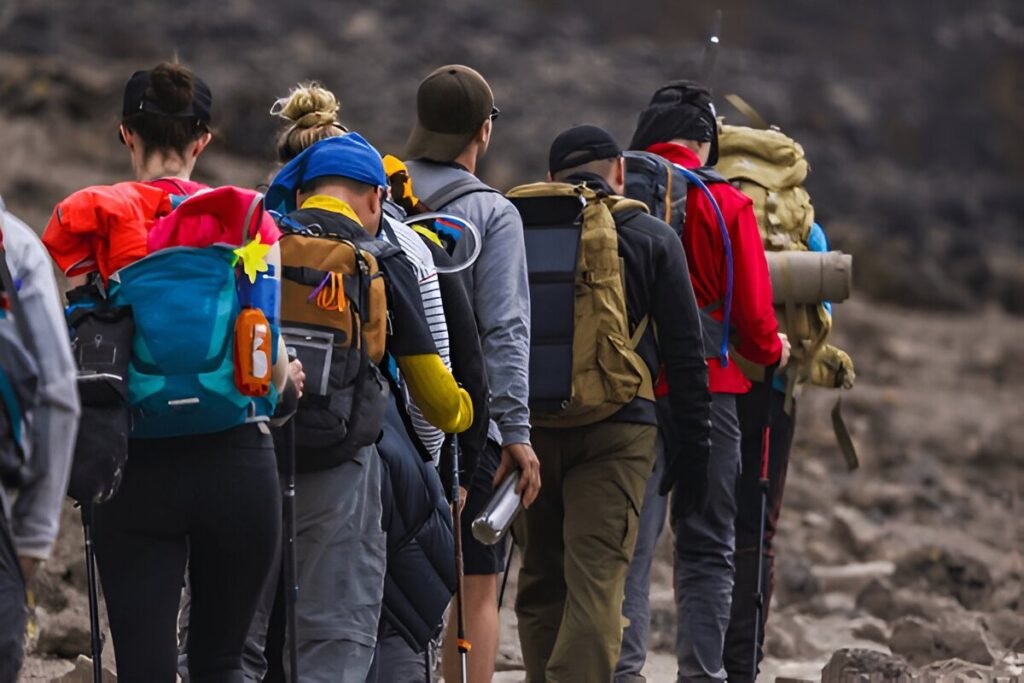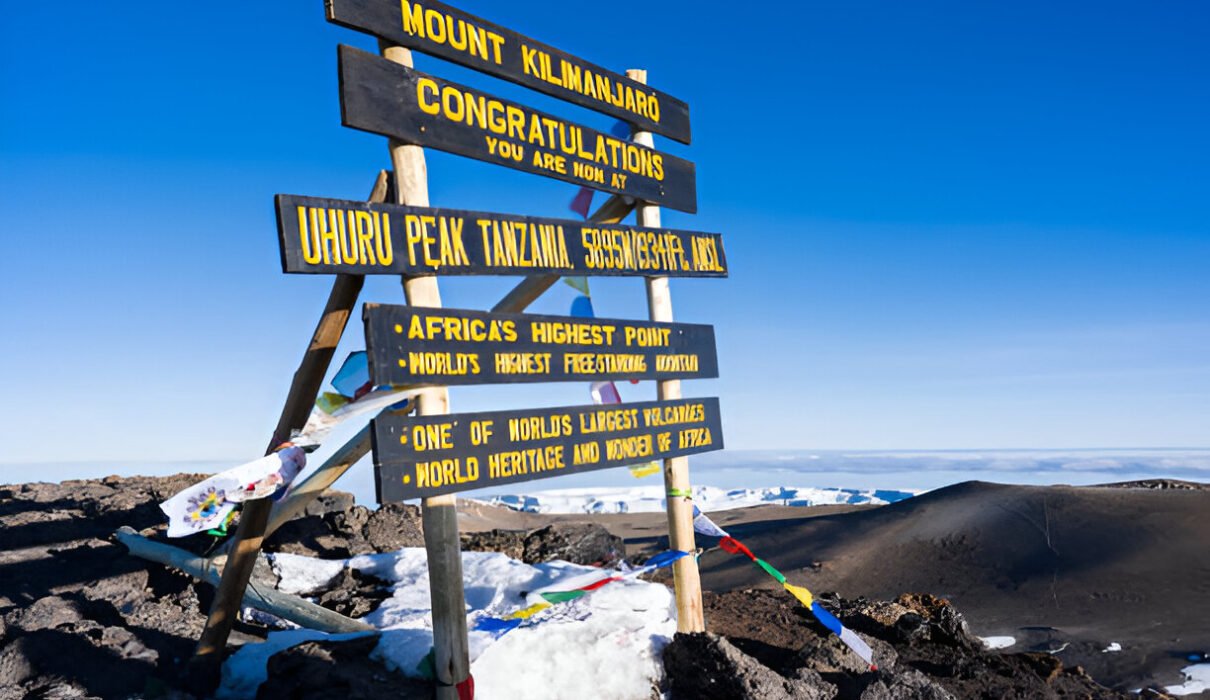Mount Kilimanjaro is not only the tallest mountain in Africa, but it also holds a wealth of intriguing stories, geological significance, and breathtaking landscapes. Located in Tanzania, this majestic mountain has attracted adventurers, climbers, and nature enthusiasts from around the world.
Here are 10 interesting facts about Mount Kilimanjaro that make it a unique and awe-inspiring destination for climbers and travelers alike.

1. Mount Kilimanjaro Is the Tallest Free-Standing Mountain in the World
Unlike many other mountains that are part of ranges, Mount Kilimanjaro stands alone, making it the tallest free-standing mountain in the world. It rises to a staggering height of 5,895 meters (19,341 feet) above sea level.
This unique feature draws thousands of climbers each year who want to conquer its peak, known as Uhuru Peak.
Learn more about climbing Kilimanjaro with Kilimanjaro Climb Specialist
2. Kilimanjaro Is a Dormant Volcano
Mount Kilimanjaro is made up of three distinct volcanic cones: Kibo, Mawenzi, and Shira.
- Kibo is the highest and the only dormant cone, meaning it could potentially erupt again.
- Mawenzi is the second-highest cone, standing at 5,149 meters (16,893 feet), and is considered extinct.
- Shira is the oldest and shortest cone, now a plateau after having collapsed, and is also extinct.
The last significant volcanic activity occurred over 360,000 years ago, and although it’s currently dormant, climbers can still witness the crater at Kibo’s summit.
Explore more about Kilimanjaro’s volcanic history
3. Kilimanjaro Is Home to Five Distinct Ecological Zones
As you ascend Kilimanjaro, you pass through five distinct ecological zones, each with its own climate, flora, and fauna. The zones include:
- Cultivation Zone (800m-1,800m): Fertile farmland at the base of the mountain.
- Rainforest Zone (1,800m-2,800m): Lush forests home to wildlife like colobus monkeys.
- Heath Zone (2,800m-4,000m): Shrubs and unique plant life like giant groundsels.
- Alpine Desert Zone (4,000m-5,000m): Barren, rocky terrain with little vegetation.
- Arctic Summit Zone (5,000m-5,895m): Glaciers and snow cover the summit.
These rapidly changing environments make Kilimanjaro one of the most unique mountains in the world.
Discover Kilimanjaro’s diverse ecosystems with Eddy Tours Safaris
4. Kilimanjaro Is Known as “The Roof of Africa”
Due to its height and visibility from miles away, Mount Kilimanjaro is often referred to as the Roof of Africa. From the summit, climbers can take in panoramic views of Tanzania and even see neighboring Kenya on clear days.
The nickname reflects both its towering presence and its significance as the highest point on the African continent.
Find out more about Kilimanjaro’s significance
5. The First Successful Ascent Was in 1889
Mount Kilimanjaro was first successfully climbed by Hans Meyer and Ludwig Purtscheller on October 6, 1889. It took them several attempts before they reached Uhuru Peak, the highest point of Kibo.
Their historic climb paved the way for thousands of adventurers who now seek to follow in their footsteps and summit Africa’s tallest mountain.
Learn about Kilimanjaro’s climbing history
6. You Don’t Need Technical Climbing Skills to Reach the Summit
Unlike many other high-altitude mountains, climbing Kilimanjaro doesn’t require any technical mountaineering skills. This makes it accessible to a wide range of adventurers.
However, climbers must be prepared for the physical challenge, as the altitude and changing climate can be tough. Proper preparation, fitness, and acclimatization are crucial to successfully reaching the summit.
Get ready to climb Kilimanjaro with Kilimanjaro Climb Specialist
7. The Glaciers on Kilimanjaro Are Rapidly Disappearing
Kilimanjaro’s iconic glaciers are slowly disappearing due to climate change. Over the past century, the ice cap has shrunk dramatically, and scientists estimate that the glaciers may completely vanish within a few decades if current trends continue.
The shrinking glaciers not only affect the mountain’s appearance but also serve as a reminder of the broader environmental changes happening across the globe.
Read about the impact of climate change on Kilimanjaro’s glaciers
8. Kilimanjaro Supports Diverse Wildlife
Though it’s a mountain, Kilimanjaro is home to a surprising variety of wildlife, especially in the lower altitudes. In the Rainforest Zone, you might encounter blue monkeys, colobus monkeys, and even elephants.
Leopards have also been spotted in the Heath Zone, and several bird species, including the Malachite Sunbird, make their home on the mountain.
Explore the wildlife you can see on Kilimanjaro
9. Kilimanjaro Was Declared a UNESCO World Heritage Site
In 1987, Mount Kilimanjaro was designated a UNESCO World Heritage Site. This prestigious status recognizes the mountain’s cultural, geological, and environmental significance.
As one of the most iconic landmarks in Africa, Kilimanjaro continues to attract global attention and efforts to preserve its unique ecosystems and heritage.
Learn more about UNESCO’s protection of Kilimanjaro
10. Around 50,000 People Attempt to Climb Kilimanjaro Every Year
Every year, about 50,000 people attempt to climb Mount Kilimanjaro, with a success rate of about 65%. The main reasons for failing to reach the summit are altitude sickness and poor acclimatization.
Climbers typically take 5 to 9 days to reach the summit, depending on the route and pace. Proper preparation, fitness, and choosing the right route are essential for a successful climb.
Get expert advice for climbing Kilimanjaro with Kilimanjaro Climb Specialist
FAQs About Mount Kilimanjaro
1. What is the best time to climb Kilimanjaro?
The best time to climb Kilimanjaro is during the dry seasons: from June to October and December to March. These months provide better weather conditions for trekking.
2. How hard is it to climb Kilimanjaro?
While Kilimanjaro doesn’t require technical climbing, it’s still physically demanding due to the altitude. Preparation and acclimatization are key to a successful climb.
3. How long does it take to climb Kilimanjaro?
Most climbers take between 5 and 9 days to reach the summit, depending on the chosen route and pace.
Start planning your Kilimanjaro trek with Kilimanjaro Climb Specialist
Final Thoughts: Mount Kilimanjaro’s Wonders
Mount Kilimanjaro is a truly remarkable natural wonder that offers a unique combination of adventure, natural beauty, and cultural significance. From its towering volcanic cones to its disappearing glaciers, the mountain continues to captivate the hearts and minds of those who set foot on its slopes.
Whether you’re planning to climb it or just marvel at its grandeur, Kilimanjaro remains one of the most iconic destinations in the world.
Start your Kilimanjaro adventure with Kilimanjaro Climb Specialist
Book your next safari with Eddy Tours Safaris

